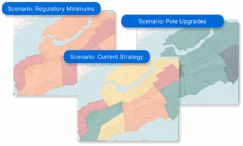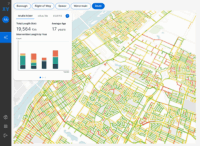How asset hierarchies drive effective decision-making
Published on November 5th, 2024
In today’s asset management climate, establishing well-defined asset hierarchies is crucial for optimizing investment strategies.
A structured asset hierarchies serves as a foundational element, enabling organizations to model, analyze, and forecast asset performance effectively, leading to effective, data-driven decision-making.
Table of Contents
What is an asset hierarchy?
An asset hierarchy organizes assets into distinct levels, from broad organizational categories to specific physical components.
This structured arrangement helps streamline decision-making processes by providing a clear view of asset relationships and dependencies.
For instance, one of the many asset hierarchies an electric utility would use regarding its substations would feature transformers, circuit breakers, and switchgears at the component level. Then the substation itself would be above the component level. The individual substations can be grouped by specific regions. And finally, the entire hierarchy would roll up to the electric utility company level, representing the organization’s overall network of assets.
Standards like ISO 14224 guide the creation of these hierarchies, ensuring comprehensive asset management across various industries.
How asset hierarchies enhance decision-making
Asset hierarchies can enhance decision-making because they play a vital role in Asset Investment Planning simulations.
By defining clear relationships and characteristics among assets, organizations can perform more accurate and insightful simulations that reflect the real-world dynamics of their asset portfolios.
Improved scenario analysis
A well-structured asset hierarchy allows for detailed scenario modeling, enabling organizations to test various investment strategies under different conditions.
For example, if an organization simulates the impact of replacing aging infrastructure, the asset hierarchy helps identify which specific components will be affected, leading to more accurate predictions of costs, benefits, and operational impacts.
Enhanced risk assessment
By organizing assets hierarchically, companies can assess the risks associated with specific assets or groups of assets more effectively.
Understanding how a failure in a parent asset (like a substation) affects its child assets (substation components) enables organizations to simulate risk scenarios accurately, helping prioritize maintenance and investment decisions based on potential impacts.
Data-driven insight
An effective asset hierarchy facilitates the integration of key performance indicators (KPIs) into simulation models.
By capturing performance data at various hierarchy levels, organizations can analyze trends and derive insights that inform investment strategies.
For example, if specific asset classes consistently underperform, simulations can guide targeted investments to improve their reliability and efficiency.
Optimized resource allocation
With clear visibility into asset relationships, organizations can simulate various investment scenarios, allowing for better forecasting and planning of resource allocations based on predicted outcomes.
Enhanced investment planning
A well-structured asset hierarchy aids in tracking and prioritizing investments, ensuring that simulations reflect strategic goals and resource allocation aligns with organizational priorities.
How to implement asset hierarchies
In order to take advantage of the enhanced decision-making asset hierarchies can bring to organizations, the first step is to adopt an Asset Investment Planning solution.
An AIP solution allows organizations to model their asset hierarchy in a way that accurately reflects the complexities and interdependencies of their infrastructure.
By adopting AIP, organizations can:
Gain a clear view of asset relationships: The hierarchical structure of assets in AIP helps visualize how different components relate to one another, supporting more precise decision-making.
Simulate different scenarios: Organizations can analyze the impact of various investment strategies on individual assets and broader asset groups, optimizing both short- and long-term planning.
Prioritize investments: With the insights derived from an organized asset hierarchy, AIP enables data-driven prioritization of maintenance and upgrade initiatives, ensuring resources are allocated to the most critical areas.
Plan for scalability and future growth: An asset hierarchy should be designed to accommodate changes in your asset portfolio over time. Flexibility ensures that as new assets are added or existing ones are upgraded, your AIP solution continues to deliver accurate simulations and analysis.
Establish a clear reporting structure: A well-organized asset hierarchy enhances visibility into asset conditions and relationships, which can be disseminated across an organization for greater consistency in decision-making in line with strategic objectives.
Create asset hierarchies with Direxyon
Direxyon’s Asset Investment Planning solutions enable organizations to build and manage asset hierarchies for every asset in their portfolios in a no-code, drag and drop environment.
By organizing assets into a clear, intuitive hierarchy, decision-makers gain the ability to see how investment scenarios and strategic goals impact their portfolios at global and granular levels.
Ready to transform the way you plan and manage your assets? Discover how Direxyon can help you unlock the full potential of your asset portfolio with our innovative Asset Investment Planning solutions.
Let us show you how it works
Our product specialists will walk you through our proven approach to enhance your capital investment planning.

Explore resources
-
 News
NewsDIREXYON Launches GO, an AI-Powered Platform to Streamline Strategic Infrastructure Investments
Read more : DIREXYON Launches GO, an AI-Powered Platform to Streamline Strategic Infrastructure InvestmentsSelf-serve Digital Twin delivers clarity to strategic infrastructure decisions Montreal, QC, September 18, 2025 – DIREXYON Technologies today announced the launch of DIREXYON GO, a self-serve platform that simplifies and accelerates Asset Investment Planning (AIP) for municipalities and utilities. DIREXYON…
-
 E-book
E-bookTurning Wildfire Data into Smarter Investments
Read more : Turning Wildfire Data into Smarter InvestmentsYour wildfire data can do more than predict where fires may spread. It can guide the decisions that protect your grid and your communities. Wildfire threats are rising, regulations are tightening, and budgets are stretched thin. Utilities need more than…
-
 Blog
BlogWhat is Strategic Asset Management?
Read more : What is Strategic Asset Management?Strategic Asset Management is more than a buzzword. It’s a transformative shift in how municipalities and electric utilities manage infrastructure, budgets, and long-term risk. At its core, strategic asset management is about using data to make better decisions. Instead of…
